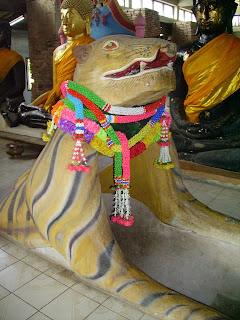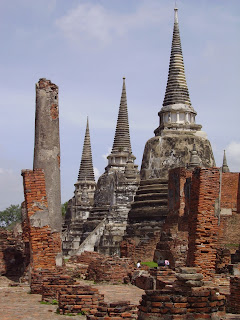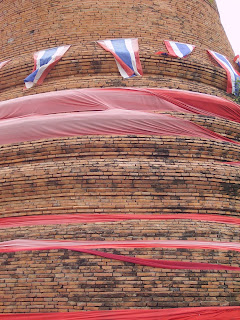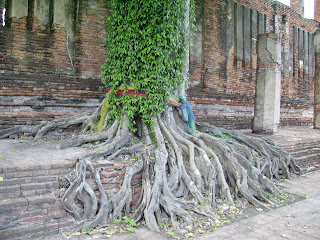 The royal capital of Siam (Thailand) from 1350 to 1767 (after which it moved to Bangkok), Ayuthaya was established as an island trading port because it was encircled with rivers leading to the gulf (the Chao Phraya, Pa Sak and Lopburi). Visited by all the European and Asian powers of the time, including the Dutch, Portuguese, French, English, Chinese and Japanese, merchants helped increase the city's population to a million in the 17th century, making it one of the wealthiest and most powerful cities in Asia. It was so powerful that despite their efforts, Europeans were never able to colonize the kingdom of Siam perhaps because of its Sanskrit name Ayodhya meaning 'undefeatable'. Yet, it was a fellow Asian power, the Bago based kingdom of Burma which sacked Ayuthaya in 1767 astride their battle-trained elephants, and despite being a Buddhist power, they desecrated the temples and other royal edifices and took many slaves back to the Burmese court.
The royal capital of Siam (Thailand) from 1350 to 1767 (after which it moved to Bangkok), Ayuthaya was established as an island trading port because it was encircled with rivers leading to the gulf (the Chao Phraya, Pa Sak and Lopburi). Visited by all the European and Asian powers of the time, including the Dutch, Portuguese, French, English, Chinese and Japanese, merchants helped increase the city's population to a million in the 17th century, making it one of the wealthiest and most powerful cities in Asia. It was so powerful that despite their efforts, Europeans were never able to colonize the kingdom of Siam perhaps because of its Sanskrit name Ayodhya meaning 'undefeatable'. Yet, it was a fellow Asian power, the Bago based kingdom of Burma which sacked Ayuthaya in 1767 astride their battle-trained elephants, and despite being a Buddhist power, they desecrated the temples and other royal edifices and took many slaves back to the Burmese court.
Walking around the grounds now, it is common to come across beheaded Buddhas, conquered as if they, too, were one of the enemy assailants. In fact, it is rare to see a Buddha that is unscarred.
 The complex is separated into two districts, those on the island (including the central city) and those off the island. On the island is the former biggest temple in Thailand, the 14th century Wat Phra Si Sanphet, used as the royal temple-palace, with at 16m standing gold buddha (gold melted down by the conquerers, of course), replaced next door with a huge bronze buddha in the 1950s.
The complex is separated into two districts, those on the island (including the central city) and those off the island. On the island is the former biggest temple in Thailand, the 14th century Wat Phra Si Sanphet, used as the royal temple-palace, with at 16m standing gold buddha (gold melted down by the conquerers, of course), replaced next door with a huge bronze buddha in the 1950s.

Don't miss the Wat Phra Mahatha with its buddha head engulfed by tree roots. Off the island is the Wat Phanan Choeng, older than Ayuthaya as a capital and probably Khmer in origin, it has a 19m sitting buddha which is still draped in saffron cloth by Buddhist pilgrims. An interesting story in the sacking of Ayuthaya surrounds the bridge to Wat Na Phra Mehn, which is surprisingly undestroyed. This is because Burmese King Along Phaya chose this temple to be fired upon by canon, but the cannon exploded and injured him, thus ending the sacking (which followed two years of war and persistent attacks from the Burmese).
Lonely Planet South East Asia on a Shoestring 12th Edition




























No comments:
Post a Comment